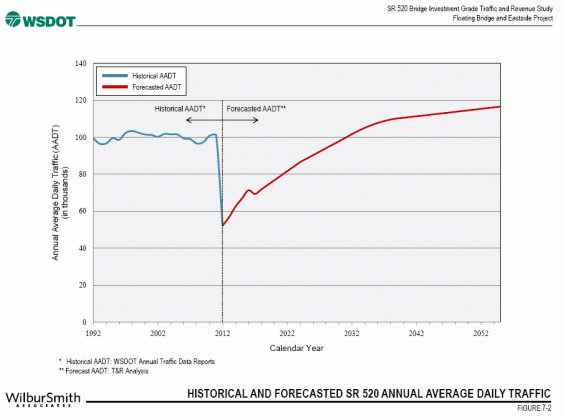Hey gang! We’ve got a new report out today: a literature review on the accuracy of tolling revenue forecasts. In a nutshell, both national and international experience shows that official tolling forecasts tend to overestimate real-world toll road revenue—particularly where drivers can choose alternative, toll-free routes. If the research holds true for our part of the world, there could be lots of implications for highway finance. Read on for more…
It seems like everywhere I look, there’s another story in the news about road tolls. Which shouldn’t be too surprising: every highway megaproject on the books in the states of Washington and Oregon—the Columbia River Crossing, Washington’s SR 520 floating bridge, Seattle’s deep bore tunnel—is counting on robust tolling revenue to help pay for the project costs.
The first up will be SR 520: the state plans to begin tolling the span in December, as part of a bid to raise $1 billion in revenue (about a quarter of the project’s costs) from the drivers who use the facility. To raise that much money, the state is planning to charge $3.50 for a rush-hour trip—or more, if you don’t pay electronically—and up to $2.20 each way on weekends. For a regular rush-hour commuter, the tolls will add about $1,750 to the cost of a year’s trips to and from work. It’s enough money to make many drivers look for other ways across the lake—other routes, other times of day, or even switching to transit. And it’s also enough to convince lots of occasional drivers that a trip on SR 520 across the lake just isn’t worth it.
The state seems to agree. As the chart shows, from a recent analysis released by WSDOT, shows that the tolls could cut SR 520 traffic by nearly 50 percent overnight, and slowly creep back to today’s levels by 2032. (Note that traffic declines on a tolled SR 99 tunnel are expected to be even steeper!)
Still, even with steep declines in traffic, the state is confident that the SR 520 tolls will easily pay off a cool billion in bonds. One WSDOT official called the study’s findings “ultraconservative.”
But should the public share WSDOT’s confidence? If history is any guide…maybe not so much. We just finished reviewing the national and international literature on road tolling, and the conclusion is clear: official forecasts systematically overestimate both traffic volumes and revenue on tolled facilities.
More troublingly, the tendency to overestimate is greatest where there are alternative, toll-free routes nearby. So if SR 520 gets steep tolls, and I-90 to the south and SR 522 to the north have no tolls, it’s reasonable to expect to see massive, long-term traffic diversion—diversion that could put WSDOT at risk of substantial toll revenue shortfalls.
It’s all in our new report: Toll Avoidance and Transportation Revenue.
It’s interesting to consider all this in the context of Washington’s Initiative 1125, on this fall’s ballot. In effect, I-1125 would prohibit corridor-wide tolling: for SR 520 the state would have no choice but to leave parallel routes toll-free. That would put the funding stream for SR 520 in even greater danger, while boosting congestion on I-90 and SR 522. I’ll leave it to others to decide whether, from the standpoint of the authors of I-1125, these effects are “bugs” or “features.”


Comments are closed.